
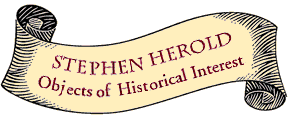
Antiquities Sold
Rare Rectangular Anatolian-Syrian Seal from c. 3000 B.C.
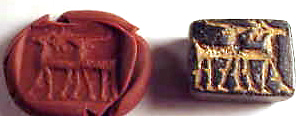 There
were several different seal forms used in Western Asia during the 4th to 1st
millenia B.C. One of the scarcest is this rectangular amulet form that was used
in southern and eastern Anatolia and northern Syria from c. 3,500 B.C. to 2,000
B.C. It is a development from the square, flat amuletic seals that were most
popular in the 4th millenium throughout the Levant but probably of Egyptian
origin. This is a partiularly elegant example in black steatite of some 21 mm
drilled longitudinally for suspension.
There
were several different seal forms used in Western Asia during the 4th to 1st
millenia B.C. One of the scarcest is this rectangular amulet form that was used
in southern and eastern Anatolia and northern Syria from c. 3,500 B.C. to 2,000
B.C. It is a development from the square, flat amuletic seals that were most
popular in the 4th millenium throughout the Levant but probably of Egyptian
origin. This is a partiularly elegant example in black steatite of some 21 mm
drilled longitudinally for suspension.
Animals, and especially animals in pairs or threes, were very common on stamp
seals from this region, either as symbols of the gods or as protective, sacrifical
offerings. In this case we have a stag and a caproid, likely a gazelle. They
are well carved to neatly fill the available space and march like a decorative
frieze. Most Syrian and Anatolian animal seals are more chaotically arranged,
with small elements to fill empty spaces at random. In this case it is more
like the formal decoration on palace friezes and was a clearly special piece
in its day. The seal comes with a description and dating by Professor Lambert
of Manchester University, and provenance from an important New York dealer.
Very fine condition with documentation.
$195.00 SOLD
Byzantine Bronze Seal from c. 800 A.D.
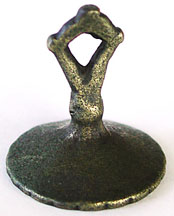 A
Byzantine bronze seal with three lines of inscription dating from c. 800 A.D.
It is a modern metal detector find and comes from the old Roman and Byzantine
fortress of Nish in Serbia. It seems that it belonged to a man named "John"
and has his titles listed below his name, possibly a local patriarch. This is
an ancient and long used seal shape, as I have seen examples from 3,000 B.C.
to the 20th century. This seal dates from the time of the Empress Irene, the
end of the destructive Iconoclast struggle in Byzantium and of the Empire of
Charlemage in Europe. Charlemagne had close relations with Irene and the Byzantines,
and Nish was likely active as a trading town then. Soon after, the Byzantines
lost the town to the Bulgars, and then to the Serbs, ending the last vestige
of the Roman Empire in the West. (Note flipped, right-reading image at right
bottom.)
A
Byzantine bronze seal with three lines of inscription dating from c. 800 A.D.
It is a modern metal detector find and comes from the old Roman and Byzantine
fortress of Nish in Serbia. It seems that it belonged to a man named "John"
and has his titles listed below his name, possibly a local patriarch. This is
an ancient and long used seal shape, as I have seen examples from 3,000 B.C.
to the 20th century. This seal dates from the time of the Empress Irene, the
end of the destructive Iconoclast struggle in Byzantium and of the Empire of
Charlemage in Europe. Charlemagne had close relations with Irene and the Byzantines,
and Nish was likely active as a trading town then. Soon after, the Byzantines
lost the town to the Bulgars, and then to the Serbs, ending the last vestige
of the Roman Empire in the West. (Note flipped, right-reading image at right
bottom.)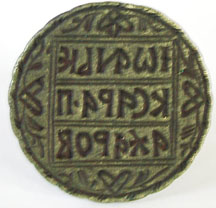
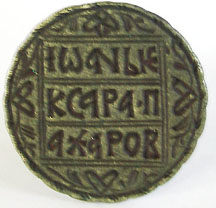
Very Good condition.
$300.00 SOLD
Jemdat Nasr Ivory Cylinder Seal from 3100-2900 B.C.
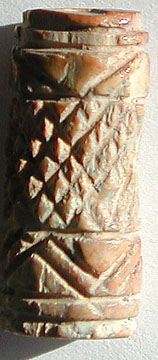 A
nice and scarce ivory cylinder seal with a "net" pattern, triangular,
zig-zag borders and single line edges dating from the early Sumerian Jemdat
Nasr period, c. 3100-2900 B.C.E. The net pattern is intended to portray a hunting
net, and on some seals we actually see animals captured in it. The early Sumerians,
and indeed most early peoples, were descended from hunter-farmers, and hunting
was both important and had high social status. The Roman animal fight games,
which were much more common than gladitorial fights, are a later example of
this, and it is still seen in such rituals as the English fox hunt. The triangular
cut ends portray the appearance of the gold mountings that these seals had.
Ivory was a scarce and sought after material in those times and this was a seal
of someone special. Ivory is a fragile and easily destroyed material that both
rots and burns, and few ivory artifacts survive today. 18 mm tall by 9 mm diameter.
A
nice and scarce ivory cylinder seal with a "net" pattern, triangular,
zig-zag borders and single line edges dating from the early Sumerian Jemdat
Nasr period, c. 3100-2900 B.C.E. The net pattern is intended to portray a hunting
net, and on some seals we actually see animals captured in it. The early Sumerians,
and indeed most early peoples, were descended from hunter-farmers, and hunting
was both important and had high social status. The Roman animal fight games,
which were much more common than gladitorial fights, are a later example of
this, and it is still seen in such rituals as the English fox hunt. The triangular
cut ends portray the appearance of the gold mountings that these seals had.
Ivory was a scarce and sought after material in those times and this was a seal
of someone special. Ivory is a fragile and easily destroyed material that both
rots and burns, and few ivory artifacts survive today. 18 mm tall by 9 mm diameter.
Good condition with some chipping to the ends.
$250.00 SOLD
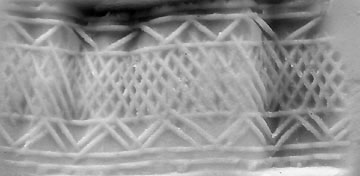
Celtic-Thracian Silver Neck Torc – 3rd to 2nd Century B.C.
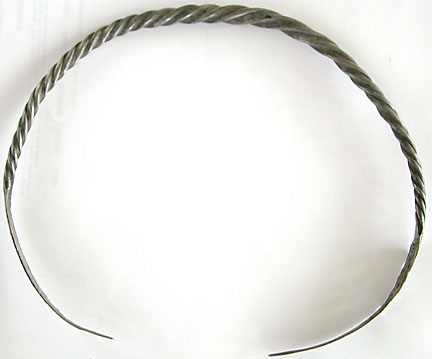 A
wonderful silver torc from Bulgaria by the Dardanian Celts who settled on the
lower Danube. This area, called Moesia by the Romans, adjoined the Thracians
who were also fine metal workers from ancient times. There is a degree of borrowing
and fusion in this region where civilization meets the steppes and trade flows
from all directions. Unfortunately war and invasion also swept this region repeatedly.
A
wonderful silver torc from Bulgaria by the Dardanian Celts who settled on the
lower Danube. This area, called Moesia by the Romans, adjoined the Thracians
who were also fine metal workers from ancient times. There is a degree of borrowing
and fusion in this region where civilization meets the steppes and trade flows
from all directions. Unfortunately war and invasion also swept this region repeatedly.
The Celts were divided into the Eastern and Western Celts, the Western in the
British Isles, France, Spain and Italy. They mixed more with the Greeks and
Romans and developed the later La Tene culture. The Eastern Celts of Germany,
Hungary, the Balkans and Asia Minor remained closer to the original Halstatt
culture and were either more aggressive or under greater pressure to migrate.
The Dardanians were one of the Eastern Celt tribes which took part in Brennius’
3rd century B.C. invasion of Greece, the sack of Delphi and the invasion of
Asia Minor. The Dardanians quit the invasion before reaching Greece and settled
at the mouth of the Danube where they remained for many centuries. Their coinage
is also a distinctive Celtic-Greek blend.
 This
torc is made from two bars of silver twisted together in the traditional Celtic
manner, and then hammer-welded together and shaped at the ends. The ends are
stylized snake heads. There is a series of holes where either stones or enamel
were placed or rivets had been located. Overall a lovely piece of Celtic metalwork.
This
torc is made from two bars of silver twisted together in the traditional Celtic
manner, and then hammer-welded together and shaped at the ends. The ends are
stylized snake heads. There is a series of holes where either stones or enamel
were placed or rivets had been located. Overall a lovely piece of Celtic metalwork.
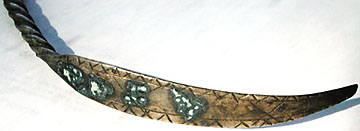 Overall
the piece is clean and in very fine condition with a dull gray patina of age.
It is 5.5 x 4.75 inches across and weighs 2 ozs. It still can be worn as jewelry.
Overall
the piece is clean and in very fine condition with a dull gray patina of age.
It is 5.5 x 4.75 inches across and weighs 2 ozs. It still can be worn as jewelry.
VF with a rich silver-gray patina
$350.00 SOLD

An English bronze bishops seal from c. 1500 A.D.
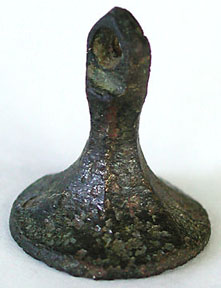
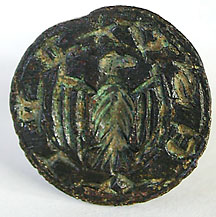 The
seal of a late-Medieval/early Renaissance bishop from Suffolk, a rich English
area in southern East Anglia near London. It likely dates from the reigns of
Henry the 7th or early Henry the 8th (while he was still Catholic, before he
started the Church of England, took so many wives and cut off their heads),
although at least one scholar thinks it is much earlier. It shows a very deeply
engraved German-style Eagle and the Lombardic script inscription ESV * DNI (=
“Episcopus * Domini”, or Bishop of the Lord). The Germanic style
eagle may accurately reflect the International nature of the Catholic Church
then, where Italian bishops were found everywhere, and bishops of all nationalities
were found in most countries. That all changed with the Protestant Reformation
which was nationalist as much as religious. A metal detector find. Would make
an attractive watch fob or necklace.
The
seal of a late-Medieval/early Renaissance bishop from Suffolk, a rich English
area in southern East Anglia near London. It likely dates from the reigns of
Henry the 7th or early Henry the 8th (while he was still Catholic, before he
started the Church of England, took so many wives and cut off their heads),
although at least one scholar thinks it is much earlier. It shows a very deeply
engraved German-style Eagle and the Lombardic script inscription ESV * DNI (=
“Episcopus * Domini”, or Bishop of the Lord). The Germanic style
eagle may accurately reflect the International nature of the Catholic Church
then, where Italian bishops were found everywhere, and bishops of all nationalities
were found in most countries. That all changed with the Protestant Reformation
which was nationalist as much as religious. A metal detector find. Would make
an attractive watch fob or necklace.
Very Good condition.
$195.00 SOLD
GO TO:
Stephen Herold's Home Page
Medals Page
Society of the Golden Fleece
The Société Napoléonienne
Antiques AtoZ Home Page
Books AtoZ Home Page
 There
were several different seal forms used in Western Asia during the 4th to 1st
millenia B.C. One of the scarcest is this rectangular amulet form that was used
in southern and eastern Anatolia and northern Syria from c. 3,500 B.C. to 2,000
B.C. It is a development from the square, flat amuletic seals that were most
popular in the 4th millenium throughout the Levant but probably of Egyptian
origin. This is a partiularly elegant example in black steatite of some 21 mm
drilled longitudinally for suspension.
There
were several different seal forms used in Western Asia during the 4th to 1st
millenia B.C. One of the scarcest is this rectangular amulet form that was used
in southern and eastern Anatolia and northern Syria from c. 3,500 B.C. to 2,000
B.C. It is a development from the square, flat amuletic seals that were most
popular in the 4th millenium throughout the Levant but probably of Egyptian
origin. This is a partiularly elegant example in black steatite of some 21 mm
drilled longitudinally for suspension. 

 A
Byzantine bronze seal with three lines of inscription dating from c. 800 A.D.
It is a modern metal detector find and comes from the old Roman and Byzantine
fortress of Nish in Serbia. It seems that it belonged to a man named "John"
and has his titles listed below his name, possibly a local patriarch. This is
an ancient and long used seal shape, as I have seen examples from 3,000 B.C.
to the 20th century. This seal dates from the time of the Empress Irene, the
end of the destructive Iconoclast struggle in Byzantium and of the Empire of
Charlemage in Europe. Charlemagne had close relations with Irene and the Byzantines,
and Nish was likely active as a trading town then. Soon after, the Byzantines
lost the town to the Bulgars, and then to the Serbs, ending the last vestige
of the Roman Empire in the West. (Note flipped, right-reading image at right
bottom.)
A
Byzantine bronze seal with three lines of inscription dating from c. 800 A.D.
It is a modern metal detector find and comes from the old Roman and Byzantine
fortress of Nish in Serbia. It seems that it belonged to a man named "John"
and has his titles listed below his name, possibly a local patriarch. This is
an ancient and long used seal shape, as I have seen examples from 3,000 B.C.
to the 20th century. This seal dates from the time of the Empress Irene, the
end of the destructive Iconoclast struggle in Byzantium and of the Empire of
Charlemage in Europe. Charlemagne had close relations with Irene and the Byzantines,
and Nish was likely active as a trading town then. Soon after, the Byzantines
lost the town to the Bulgars, and then to the Serbs, ending the last vestige
of the Roman Empire in the West. (Note flipped, right-reading image at right
bottom.)

 A
nice and scarce ivory cylinder seal with a "net" pattern, triangular,
zig-zag borders and single line edges dating from the early Sumerian Jemdat
Nasr period, c. 3100-2900 B.C.E. The net pattern is intended to portray a hunting
net, and on some seals we actually see animals captured in it. The early Sumerians,
and indeed most early peoples, were descended from hunter-farmers, and hunting
was both important and had high social status. The Roman animal fight games,
which were much more common than gladitorial fights, are a later example of
this, and it is still seen in such rituals as the English fox hunt. The triangular
cut ends portray the appearance of the gold mountings that these seals had.
Ivory was a scarce and sought after material in those times and this was a seal
of someone special. Ivory is a fragile and easily destroyed material that both
rots and burns, and few ivory artifacts survive today. 18 mm tall by 9 mm diameter.
A
nice and scarce ivory cylinder seal with a "net" pattern, triangular,
zig-zag borders and single line edges dating from the early Sumerian Jemdat
Nasr period, c. 3100-2900 B.C.E. The net pattern is intended to portray a hunting
net, and on some seals we actually see animals captured in it. The early Sumerians,
and indeed most early peoples, were descended from hunter-farmers, and hunting
was both important and had high social status. The Roman animal fight games,
which were much more common than gladitorial fights, are a later example of
this, and it is still seen in such rituals as the English fox hunt. The triangular
cut ends portray the appearance of the gold mountings that these seals had.
Ivory was a scarce and sought after material in those times and this was a seal
of someone special. Ivory is a fragile and easily destroyed material that both
rots and burns, and few ivory artifacts survive today. 18 mm tall by 9 mm diameter.

 The
seal of a late-Medieval/early Renaissance bishop from Suffolk, a rich English
area in southern East Anglia near London. It likely dates from the reigns of
Henry the 7th or early Henry the 8th (while he was still Catholic, before he
started the Church of England, took so many wives and cut off their heads),
although at least one scholar thinks it is much earlier. It shows a very deeply
engraved German-style Eagle and the Lombardic script inscription ESV * DNI (=
“Episcopus * Domini”, or Bishop of the Lord). The Germanic style
eagle may accurately reflect the International nature of the Catholic Church
then, where Italian bishops were found everywhere, and bishops of all nationalities
were found in most countries. That all changed with the Protestant Reformation
which was nationalist as much as religious. A metal detector find. Would make
an attractive watch fob or necklace.
The
seal of a late-Medieval/early Renaissance bishop from Suffolk, a rich English
area in southern East Anglia near London. It likely dates from the reigns of
Henry the 7th or early Henry the 8th (while he was still Catholic, before he
started the Church of England, took so many wives and cut off their heads),
although at least one scholar thinks it is much earlier. It shows a very deeply
engraved German-style Eagle and the Lombardic script inscription ESV * DNI (=
“Episcopus * Domini”, or Bishop of the Lord). The Germanic style
eagle may accurately reflect the International nature of the Catholic Church
then, where Italian bishops were found everywhere, and bishops of all nationalities
were found in most countries. That all changed with the Protestant Reformation
which was nationalist as much as religious. A metal detector find. Would make
an attractive watch fob or necklace.